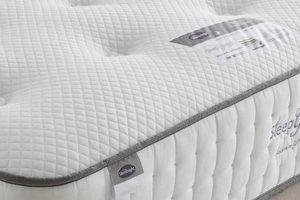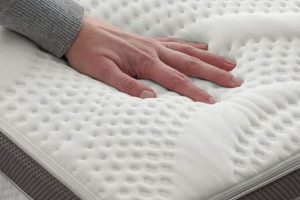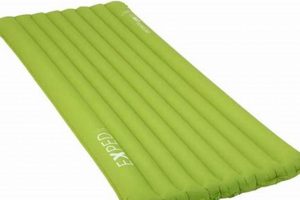These bedding accessories, produced by Sleep Innovations, are designed to enhance the comfort and support of an existing mattress. They are typically constructed from materials such as memory foam, gel-infused foam, or down alternative, and are placed on top of the mattress to modify its feel and provide additional cushioning. For example, a firm mattress can be made softer and more conforming through the addition of a memory foam layer.
The significance of these products lies in their ability to improve sleep quality and address specific comfort needs without requiring the purchase of an entirely new mattress. Benefits include pressure relief, improved spinal alignment, and temperature regulation. Historically, such add-ons have evolved from simple padding to technologically advanced materials aimed at optimizing sleep ergonomics and addressing issues like back pain and overheating.
The following discussion will delve into the various types available, factors to consider when selecting one, and their impact on overall sleep health. Furthermore, it will explore the durability, maintenance requirements, and potential drawbacks associated with these types of products.
Guidance on Mattress Topper Selection
The subsequent recommendations are designed to assist consumers in making informed decisions when selecting a mattress topper manufactured by Sleep Innovations. Attention to these factors can optimize comfort and extend the lifespan of the product.
Tip 1: Material Consideration: Evaluate the composition of the topper, noting the density and type of foam. Memory foam provides contouring and pressure relief, while gel-infused options regulate temperature. Select a material that addresses specific sleep concerns.
Tip 2: Thickness Assessment: Determine the appropriate thickness based on the existing mattress and desired level of comfort alteration. A thicker topper will significantly change the feel of the mattress, while a thinner option provides subtle enhancements.
Tip 3: Density Evaluation: High-density foam offers greater support and durability. Lower-density foam may be less expensive but will likely compress and degrade more quickly.
Tip 4: Size Verification: Ensure the topper precisely matches the dimensions of the mattress. An ill-fitting topper can slide and bunch, diminishing comfort and support.
Tip 5: Cover Inspection: The cover material influences breathability and ease of cleaning. Opt for a removable, washable cover to maintain hygiene.
Tip 6: Warranty Review: Scrutinize the manufacturer’s warranty for coverage against defects and premature degradation. A robust warranty indicates confidence in the product’s longevity.
Tip 7: Support Evaluation: Consider the level of support provided to ensure proper spinal alignment and alleviate pressure points, especially for individuals with back pain or related issues.
Adherence to these guidelines will enable a more informed purchasing decision, leading to improved sleep quality and enhanced mattress longevity. The ensuing sections will address cleaning and maintenance strategies to further maximize the topper’s lifespan and maintain optimal performance.
1. Material Composition
The material composition of Sleep Innovations mattress toppers directly dictates their performance characteristics and suitability for individual needs. The selection of materials, such as memory foam, gel-infused foam, or various blends, directly influences the topper’s ability to provide pressure relief, regulate temperature, and offer support. For instance, a memory foam topper conforms to the body’s shape, distributing weight evenly and alleviating pressure points, while a gel-infused topper mitigates heat retention, promoting a cooler sleep environment. Therefore, the material directly impacts the user experience.
Consider two practical examples: An individual experiencing back pain may benefit significantly from a high-density memory foam topper that provides enhanced support and spinal alignment. Conversely, someone prone to night sweats might find greater comfort in a gel-infused or open-cell foam topper designed to dissipate heat. The choice of material is not arbitrary; it is a critical factor in addressing specific comfort and sleep-related concerns. The practical significance lies in the ability to customize the sleeping surface to address individual needs, which ultimately enhances sleep quality and reduces discomfort.
In summary, the material composition of a Sleep Innovations mattress topper is fundamental to its functionality and effectiveness. Understanding the properties of different materials enables informed decision-making, allowing consumers to select a topper that best aligns with their individual preferences and requirements. Challenges may arise in discerning subtle differences between material blends, but prioritizing research and understanding material properties ultimately leads to a more satisfactory purchase. The impact of material selection resonates throughout the lifespan of the topper, influencing comfort, durability, and overall sleep experience.
2. Density Options
Density options within Sleep Innovations mattress toppers are a crucial determinant of support, durability, and overall comfort. The density of the foam, typically measured in pounds per cubic foot, directly correlates with its firmness and resilience. Higher-density foams offer greater resistance to compression, translating to enhanced support and prolonged lifespan. Conversely, lower-density foams provide a softer feel but are more susceptible to degradation over time. This foundational aspect significantly influences the topper’s ability to maintain its shape and provide consistent support.
Consider the practical implications: A heavier individual or someone requiring substantial back support would benefit from a high-density topper. This option will minimize sinking and maintain proper spinal alignment throughout the night. In contrast, a lighter person seeking added cushioning might find a lower-density option more suitable, providing a plush surface without sacrificing support entirely. The selection must align with individual weight, sleep position, and specific comfort needs to optimize the sleep experience. Improper density selection may result in inadequate support, premature sagging, and reduced product lifespan, leading to dissatisfaction.
In summary, understanding density options is paramount when choosing a Sleep Innovations mattress topper. It is a primary driver of support, durability, and overall value. While lower-density options may offer a cost-effective initial purchase, higher-density toppers often provide a more sustainable and supportive solution in the long term. Consumers should carefully evaluate their individual needs and prioritize density when making a selection. Challenges arise in accurately assessing density through online descriptions; therefore, consulting product specifications and reviews becomes essential to making an informed decision.
3. Thickness Variants
Thickness variants represent a critical design parameter in Sleep Innovations mattress toppers, directly influencing the degree to which the topper alters the feel of the underlying mattress. The selection of an appropriate thickness is paramount to achieving desired comfort levels and addressing specific sleep-related concerns.
- Impact on Firmness Adjustment
Thicker toppers substantially soften a firm mattress, providing a more plush and conforming surface. Conversely, thinner toppers offer a subtle enhancement, adding a layer of cushioning without drastically altering the original mattress feel. This variance caters to diverse preferences, allowing individuals to fine-tune their sleep surface to achieve optimal comfort. For example, a 4-inch topper can transform a very firm mattress into a medium-plush surface, while a 2-inch topper may only add a gentle layer of softness.
- Influence on Pressure Relief
Thickness plays a significant role in pressure relief, particularly at critical points like the shoulders and hips. Thicker toppers distribute weight more evenly, reducing pressure concentration and alleviating discomfort for side sleepers or individuals with joint pain. A thinner topper may not provide sufficient cushioning to adequately relieve pressure points, leading to continued discomfort. The effectiveness of pressure relief is directly proportional to the topper’s ability to conform to the body’s contours, a factor heavily influenced by its thickness.
- Effect on Support Characteristics
While primarily focused on comfort, thickness also indirectly affects support. A thicker topper can compensate for a sagging or uneven mattress, providing a more uniform sleep surface. However, excessive thickness may compromise support if the underlying mattress is already too soft, potentially leading to spinal misalignment. The ideal thickness strikes a balance between comfort enhancement and maintaining adequate support, ensuring proper spinal alignment and preventing lower back pain.
- Considerations for Bed Height
The addition of a mattress topper increases the overall bed height, a factor to consider in relation to bed frames and bedroom aesthetics. A thicker topper may require adjustments to bedding or even necessitate a lower bed frame to maintain comfortable access. Failure to account for increased bed height can lead to aesthetic imbalances or functional inconveniences, such as difficulty getting in and out of bed. This practical consideration underscores the importance of assessing the overall impact of topper thickness on the sleep environment.
In conclusion, the choice of thickness variants in Sleep Innovations mattress toppers is a multifaceted decision that hinges on individual comfort preferences, existing mattress characteristics, and practical considerations related to bed height. Understanding the interplay between thickness and its impact on firmness, pressure relief, support, and overall bed aesthetics is crucial for optimizing the sleep experience.
4. Support Characteristics
Support characteristics are a fundamental attribute of Sleep Innovations mattress toppers, influencing spinal alignment, pressure distribution, and overall sleep quality. The level of support provided directly impacts the user’s physical well-being by maintaining the natural curvature of the spine and minimizing pressure points. Deficiencies in support can exacerbate existing back pain or contribute to new musculoskeletal discomfort. For instance, a topper lacking adequate support may allow the sleeper’s hips to sink excessively, causing spinal misalignment and lower back strain. Conversely, a topper with appropriate support will maintain a neutral spine position, reducing the risk of pain and stiffness. The cause-and-effect relationship between support characteristics and sleep health is significant, highlighting the importance of this component in Sleep Innovations mattress toppers.
The practical significance of understanding support characteristics extends to the selection process. Consumers must consider their individual sleep position, body weight, and any pre-existing musculoskeletal conditions when choosing a topper. Side sleepers, for example, require sufficient support under the shoulders and hips to prevent spinal curvature, while back sleepers need support along the entire spine to maintain its natural arch. Sleep Innovations offers toppers with varying levels of support, ranging from plush and contouring to firm and structured. The appropriate choice depends on the individual’s specific needs and preferences. Consider a scenario where an individual with scoliosis selects a topper lacking sufficient support. The resulting spinal misalignment could exacerbate their condition and lead to increased pain and discomfort. This real-life example underscores the necessity of evaluating support characteristics before making a purchase.
In summary, support characteristics represent a critical element of Sleep Innovations mattress toppers, directly affecting spinal alignment and pressure distribution. Understanding the interplay between support and sleep health is paramount to selecting a topper that promotes proper posture and minimizes discomfort. While assessing support levels through online descriptions can be challenging, carefully considering individual needs and reading product reviews provides valuable insights. Prioritizing support characteristics ensures a more comfortable and restorative sleep experience, contributing to long-term physical well-being.
5. Temperature Regulation
Temperature regulation constitutes a critical performance attribute in Sleep Innovations mattress toppers, directly influencing sleep comfort and overall quality. The human body experiences fluctuations in temperature during sleep cycles, and the ability of a mattress topper to dissipate heat and maintain a stable sleep surface temperature significantly impacts the user’s ability to achieve and sustain restful sleep. Overheating can disrupt sleep patterns, leading to restlessness, reduced REM sleep, and diminished cognitive function. Consequently, the implementation of effective temperature regulation mechanisms in Sleep Innovations mattress toppers is not merely a comfort enhancement but a crucial factor in promoting healthy sleep habits. For example, individuals residing in warmer climates or those prone to night sweats benefit significantly from toppers incorporating cooling technologies.
The integration of temperature-regulating materials, such as gel-infused memory foam or open-cell foam structures, represents a common approach to addressing this concern. Gel-infused memory foam absorbs and dissipates body heat, preventing excessive temperature buildup within the sleeping surface. Open-cell foam structures promote airflow, facilitating heat transfer away from the body. The efficacy of these technologies directly correlates with the composition and density of the materials employed. A topper incorporating a high concentration of gel or a highly porous foam structure will exhibit superior temperature regulation properties compared to one with minimal enhancements. The selection of a topper with appropriate temperature regulation capabilities requires careful consideration of individual sleep patterns, environmental conditions, and personal preferences.
In summary, temperature regulation is a pivotal consideration in the design and selection of Sleep Innovations mattress toppers. It directly impacts sleep quality by preventing overheating and maintaining a comfortable sleep environment. While the efficacy of various temperature-regulating technologies may vary, the incorporation of features such as gel-infused foam and open-cell structures represents a significant advancement in sleep comfort. The challenge lies in accurately assessing the performance of these technologies based on product descriptions alone; therefore, consulting independent reviews and considering personal thermal preferences are essential for making an informed purchasing decision.
6. Durability Expectations
Durability expectations are a primary concern for consumers considering Sleep Innovations mattress toppers. These expectations significantly influence purchasing decisions and long-term satisfaction. The inherent materials, manufacturing processes, and usage patterns collectively dictate the lifespan and sustained performance of these bedding accessories.
- Material Resilience
The constituent materials, such as memory foam or gel-infused foam, possess inherent limitations in their ability to withstand prolonged compression and cyclical stress. Lower-density foams, while initially offering a plush feel, are prone to faster degradation compared to higher-density counterparts. This degradation manifests as reduced support, sagging, and an overall diminished comfort profile over time. Real-world examples include consumers reporting indentations and loss of loft after a year of regular use with low-density toppers.
- Manufacturing Quality and Construction
The quality of manufacturing processes directly impacts the structural integrity of the topper. Inconsistent foam pouring, substandard adhesives, and inadequate cover stitching can accelerate wear and tear. For instance, poorly bonded layers within a multi-layer topper may delaminate, creating uneven support and compromising the topper’s overall performance. Rigorous quality control measures are essential to mitigate these issues and ensure product longevity.
- Usage Patterns and Environmental Factors
The manner in which a mattress topper is used and the environmental conditions to which it is exposed influence its durability. Regular rotation and flipping (where applicable) can distribute wear more evenly, extending the lifespan. Exposure to direct sunlight, excessive humidity, or improper cleaning techniques can accelerate material degradation and shorten the product’s useful life. Specific examples include excessive sweating or liquid spills leading to premature breakdown of the foam structure.
- Warranty Provisions and Claims
The presence and terms of a manufacturer’s warranty serve as an indicator of expected durability and provide recourse in the event of premature failure. A longer warranty period often reflects greater confidence in the product’s longevity. However, warranty provisions typically exclude damage resulting from misuse or normal wear and tear. Understanding the specific terms and conditions of the warranty is crucial for managing expectations and addressing potential durability concerns.
In conclusion, durability expectations regarding Sleep Innovations mattress toppers necessitate a comprehensive assessment encompassing material resilience, manufacturing quality, usage patterns, and warranty provisions. While specific lifespan estimates vary based on these factors, informed consumers can manage their expectations and optimize product longevity through proper care and maintenance.
7. Size Compatibility
Size compatibility represents a critical, often overlooked, aspect of Sleep Innovations mattress toppers. A mismatch between the topper and mattress dimensions can negate the intended benefits, leading to discomfort, compromised support, and accelerated wear. The cause is straightforward: an ill-fitting topper shifts and bunches, creating uneven surfaces that disrupt spinal alignment and pressure distribution. The importance of accurate size matching cannot be overstated; it directly influences the topper’s performance and the user’s sleep quality. A real-life example involves a queen-sized topper placed on a full-sized mattress. The excess material overhangs the edges, creating an unstable sleep surface. This instability can lead to edge collapse, reduced support, and an overall diminished sleep experience. The practical significance lies in ensuring the topper functions as designed, providing uniform comfort and support across the entire sleep surface.
Further analysis reveals that size compatibility extends beyond simple width and length measurements. Topper thickness also plays a role. A topper that is significantly thicker than the mattress may create an excessively soft surface, negating the mattress’s inherent support. Conversely, a thin topper on an already plush mattress may offer minimal benefit. Practical applications include meticulous measurement of the existing mattress before purchasing a topper and reviewing the manufacturer’s specifications to ensure a precise fit. Consider individuals sharing a bed; an incorrectly sized topper can lead to one sleeper experiencing optimal comfort while the other suffers from uneven support due to the topper’s inadequate dimensions.
In conclusion, size compatibility is not merely a superficial concern but a fundamental requirement for realizing the full potential of Sleep Innovations mattress toppers. Overlooking this aspect can compromise comfort, support, and product longevity. While challenges may arise in accurately assessing dimensions, the benefits of precise size matching far outweigh the effort. Aligning topper dimensions with mattress dimensions ensures a uniform and supportive sleep surface, promoting restful and restorative sleep. Failure to do so renders the investment in a Sleep Innovations mattress topper largely ineffective.
Frequently Asked Questions
The following section addresses common inquiries regarding Sleep Innovations mattress toppers, providing concise and informative answers to assist consumers in making informed decisions.
Question 1: What constitutes the typical lifespan of a Sleep Innovations mattress topper?
The lifespan of these products varies depending on material composition, usage patterns, and maintenance practices. Higher-density foam toppers generally exhibit greater longevity, ranging from three to five years. Lower-density options may require replacement sooner.
Question 2: How should a Sleep Innovations mattress topper be properly cleaned and maintained?
Spot cleaning with a mild detergent is recommended for most stains. Avoid harsh chemicals or excessive moisture, which can degrade the foam. Regular airing helps to minimize odors and maintain freshness. Some toppers feature removable, washable covers.
Question 3: Can a Sleep Innovations mattress topper effectively alleviate back pain?
The effectiveness in alleviating back pain depends on the individual’s specific condition and the topper’s support characteristics. Firm, high-density options provide greater spinal alignment and pressure relief, potentially reducing discomfort. Consultation with a healthcare professional is advised for persistent pain.
Question 4: What are the primary differences between memory foam and gel-infused mattress toppers?
Memory foam conforms closely to the body, providing pressure relief. Gel-infused options incorporate cooling technology to mitigate heat retention. The choice depends on individual preferences for temperature regulation and contouring.
Question 5: How does the thickness of a mattress topper affect its performance?
Thicker toppers significantly alter the feel of the underlying mattress, providing greater cushioning and support. Thinner options offer a subtle enhancement. The appropriate thickness depends on the existing mattress firmness and desired comfort level.
Question 6: Are Sleep Innovations mattress toppers compatible with adjustable beds?
Compatibility with adjustable beds depends on the topper’s flexibility and construction. Thinner, more pliable options are generally better suited for adjustable bed frames. Consult the manufacturer’s specifications for specific compatibility information.
These answers provide a basic understanding of Sleep Innovations mattress toppers. Individual circumstances and specific product features should be carefully considered before making a purchase.
The next section will delve into potential drawbacks and considerations associated with these bedding accessories.
Conclusion
The preceding analysis has explored various facets of Sleep Innovations mattress toppers, encompassing material composition, density options, thickness variants, support characteristics, temperature regulation, durability expectations, and size compatibility. A comprehensive understanding of these elements is crucial for consumers seeking to enhance their sleep environment and address specific comfort needs. Selection requires careful consideration of individual requirements and a thorough evaluation of product specifications.
Ultimately, the effectiveness of Sleep Innovations mattress toppers hinges on informed decision-making and responsible product maintenance. While these bedding accessories offer potential benefits in terms of comfort and support, their long-term performance and value are contingent upon aligning product features with individual needs and adhering to recommended care guidelines. Further research and consultation with qualified professionals may be beneficial for those with complex sleep-related concerns.







